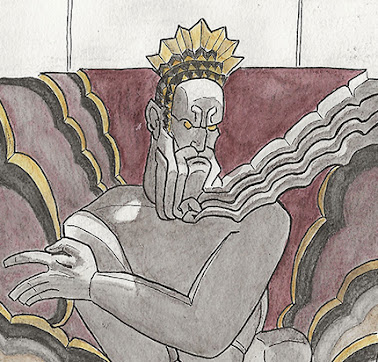While Lee Lawrie receives credit for the most pieces of work at Rockefeller Center, Léon-Victor Solon (1873-1957) created the coloring for more than 87 sculptures. Solon came from a family of distinguished English ceramics artists. He emigrated to the United States in 1909 and began work for tiling companies.
Classically trained in the arts, Solon was particularly fascinated by research into Greek polychromy, the painting schemes originally applied to classical sculpture and architecture. Solon lamented the "dull and lifeless buildings of today" and advocated increased use of color in modern architecture. "A soothing green would be suitable for localities like the Wall Street district where nerves are subject to constant excitement," he wrote. Solon had learned that the German manufacturer Keim had developed a paint that bonded to limestone, which he then used for the Wisdom, Sound and Light sculptures. On the basis of that work, Solon was hired to be the colorist for the entire center, creating color schemes for 87 pieces. So, while Lawrie is credited for 14 pieces in the complex, it could be said that it is Solon's work which is most prevalent throughout the project.
Three more pieces by Lawrie and Solon. Progress is above the 49th St. entrance. It features Columbia, a traditional female symbol of America, holding a flame of divine fire in one hand, and an olive branch, symbol of peace, in the other. She is accompanied by Pegasus, a symbol of inspiration, and an eagle, symbol of power.
Winged Mercury is an intaglio relief above the entrance at 620 Fifth Ave. It represents the wealth and vitality of the British merchant fleets.
Cornucopia of Plenty, above the entrance at 10 West 51st St., symbolizes "the plentitude that would result from well-organized international trade."
Commerce and Industry With a Caduceus, at 636 Fifth Avenue, is not a Lawrie piece. It's by Attilo Piccirilli, an Italian immigrant whose family is responsible for many of the most famous sculptures in New York City. Attilio was also the sculptor of the statue of Lincoln at the Lincoln Memorial. The male figure represents commerce, the female symbolizes industry, and the caduceus is a symbol of Mercury, god of trade.











